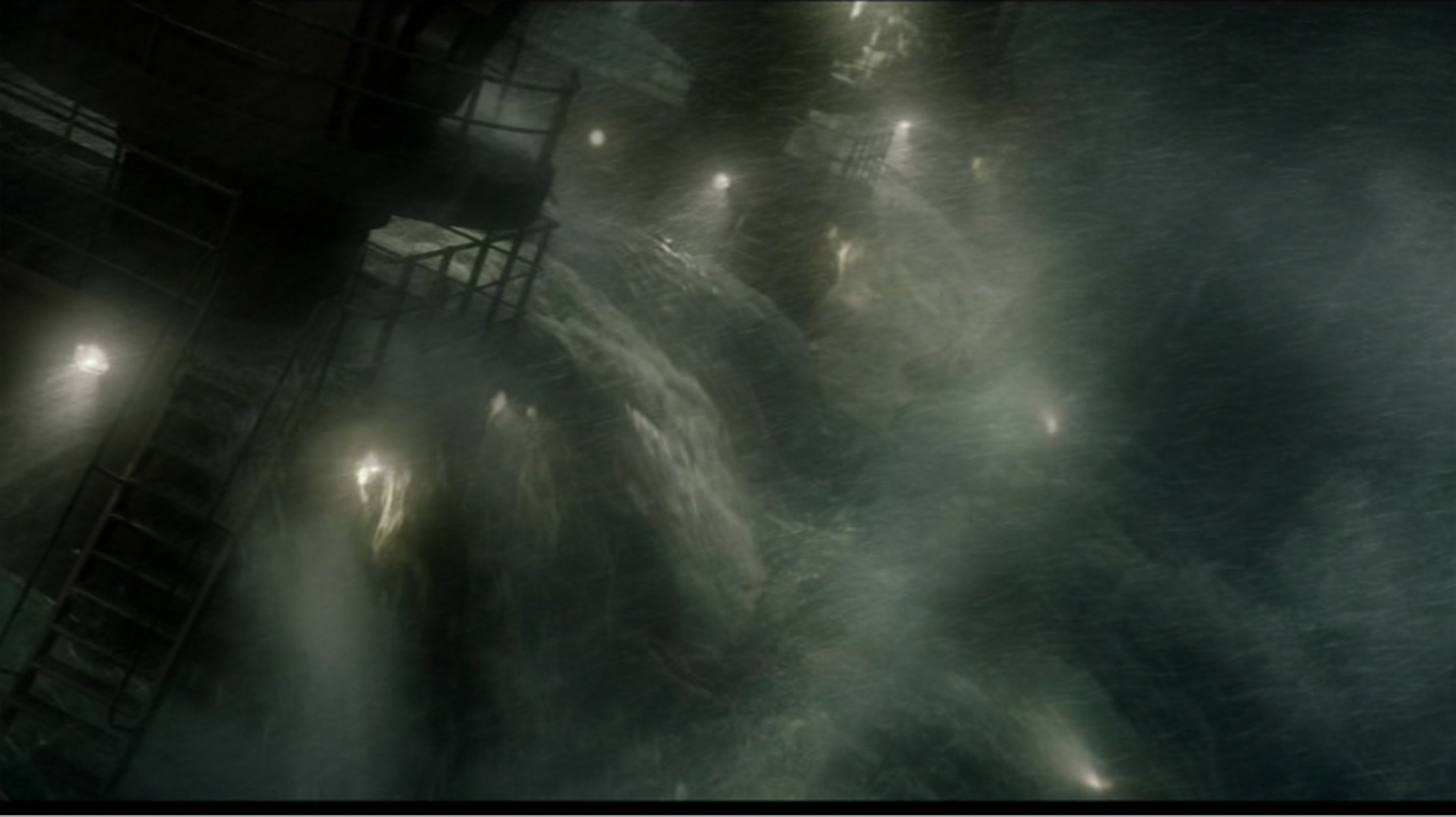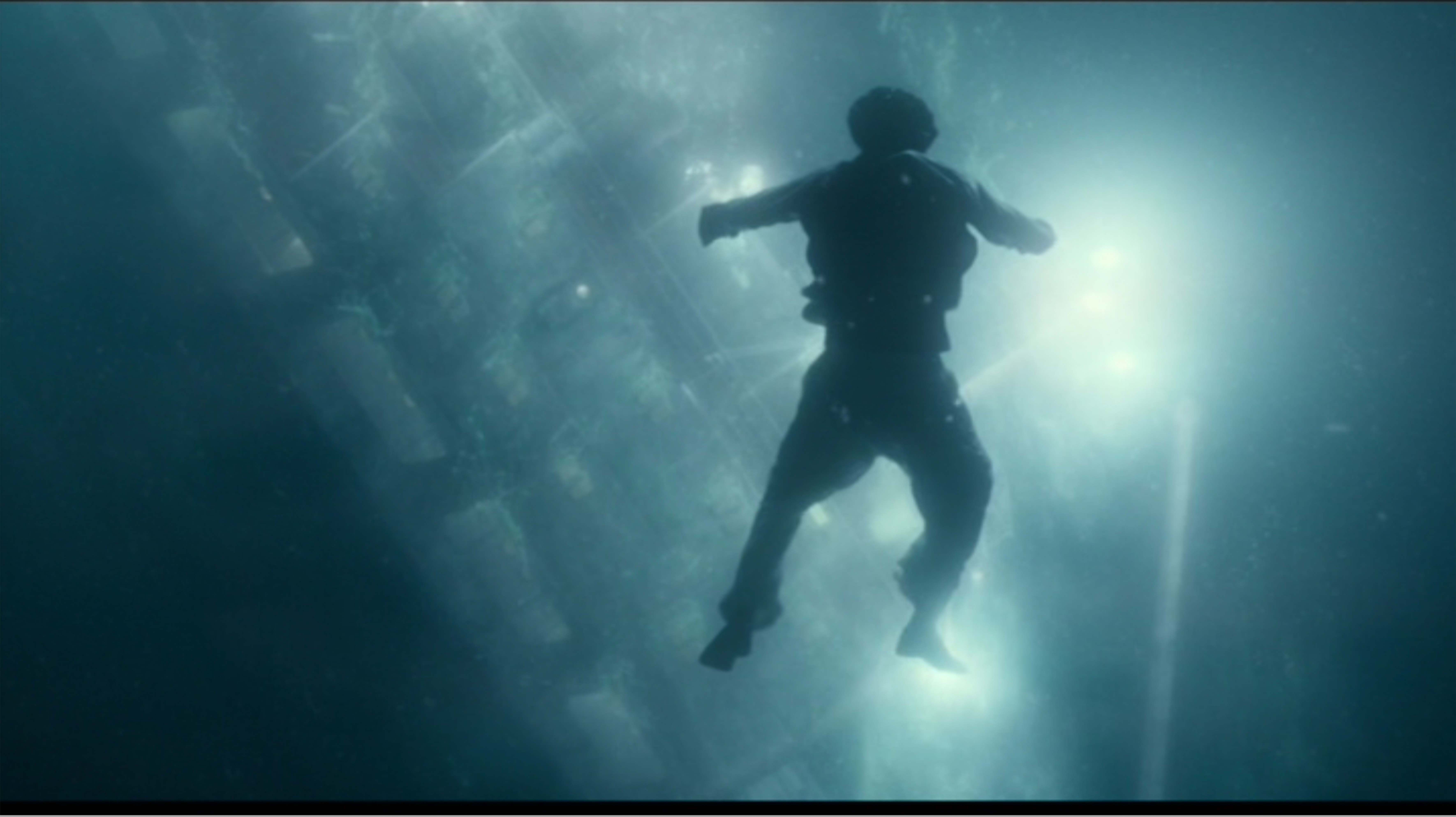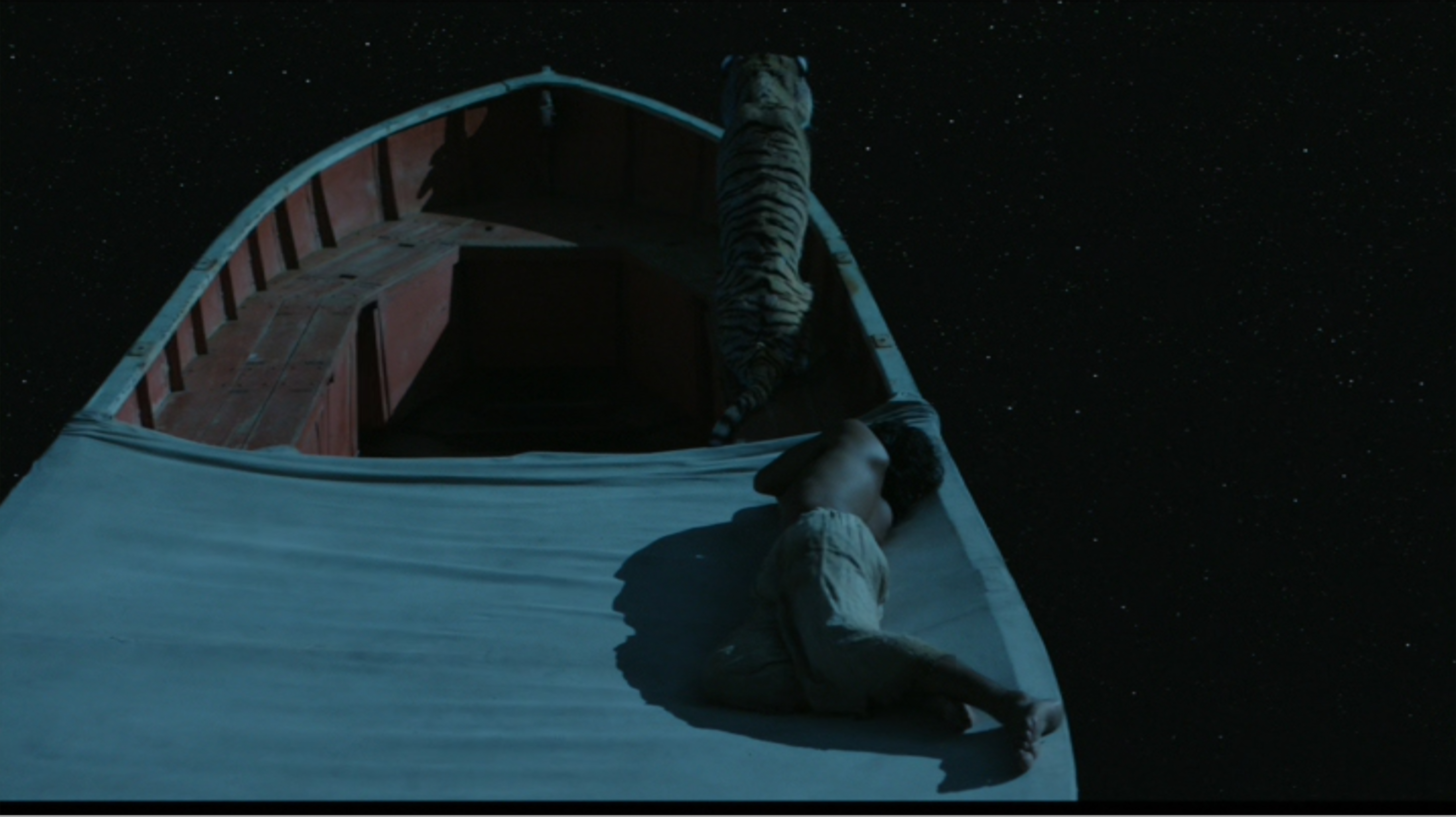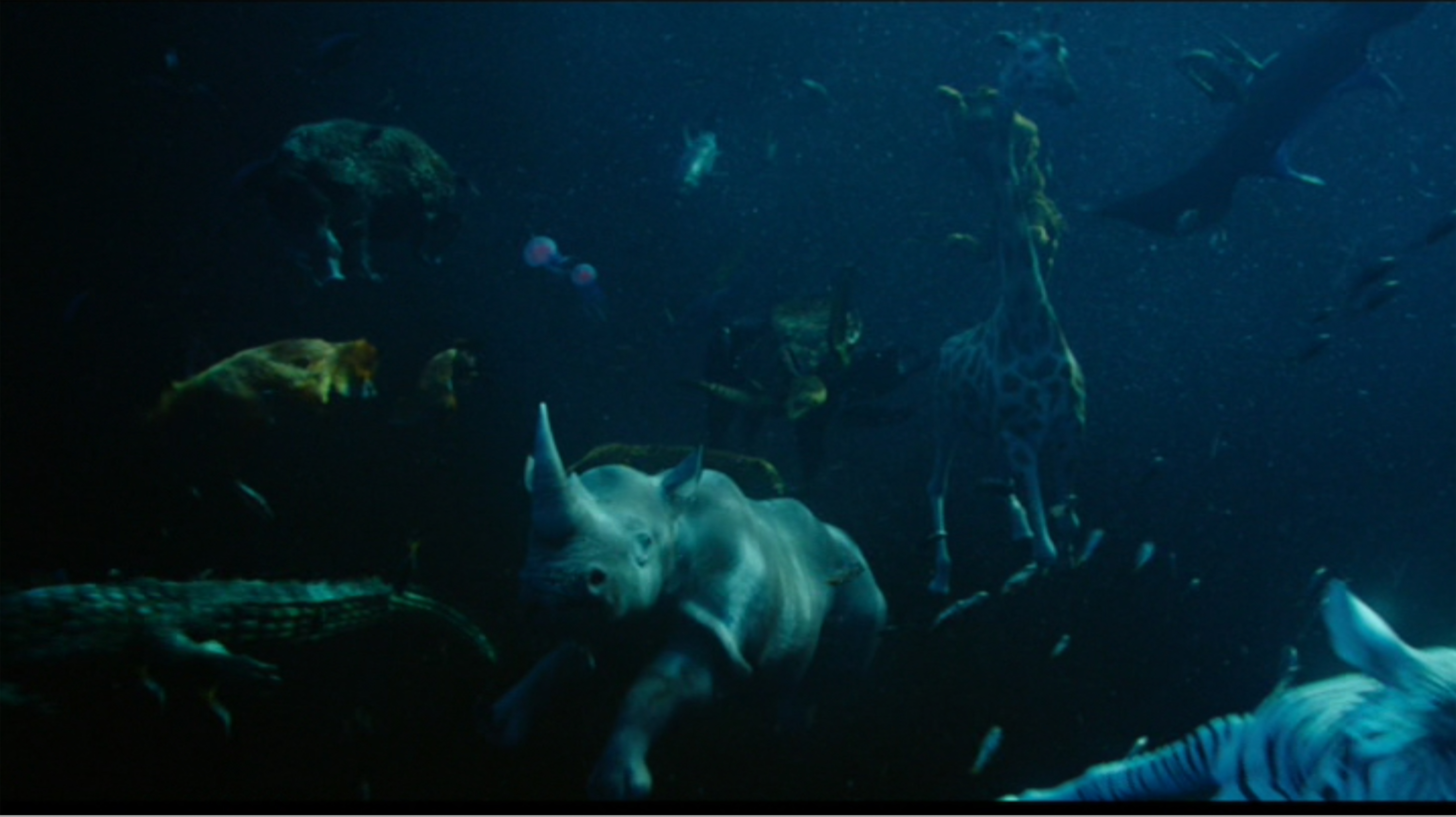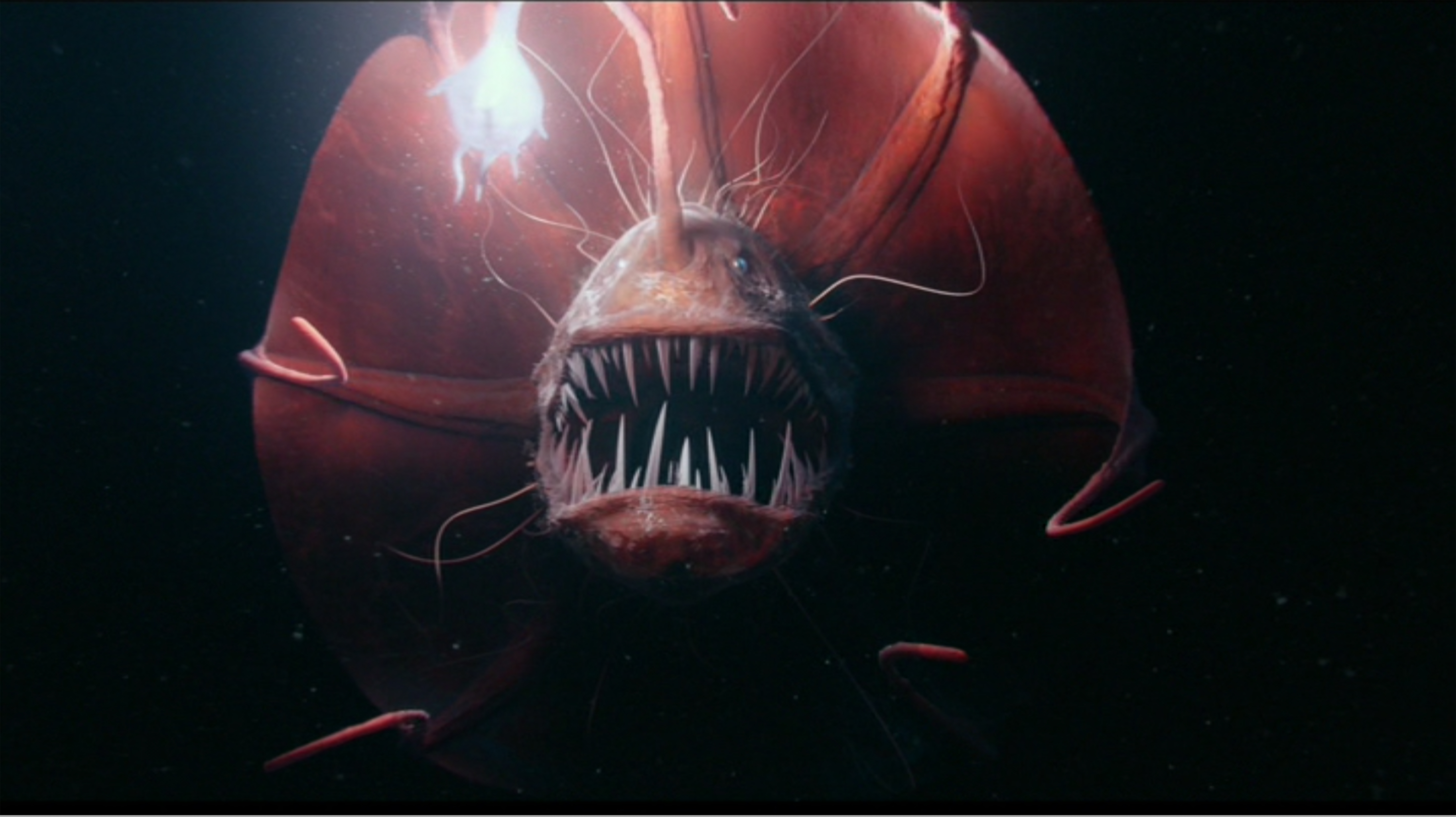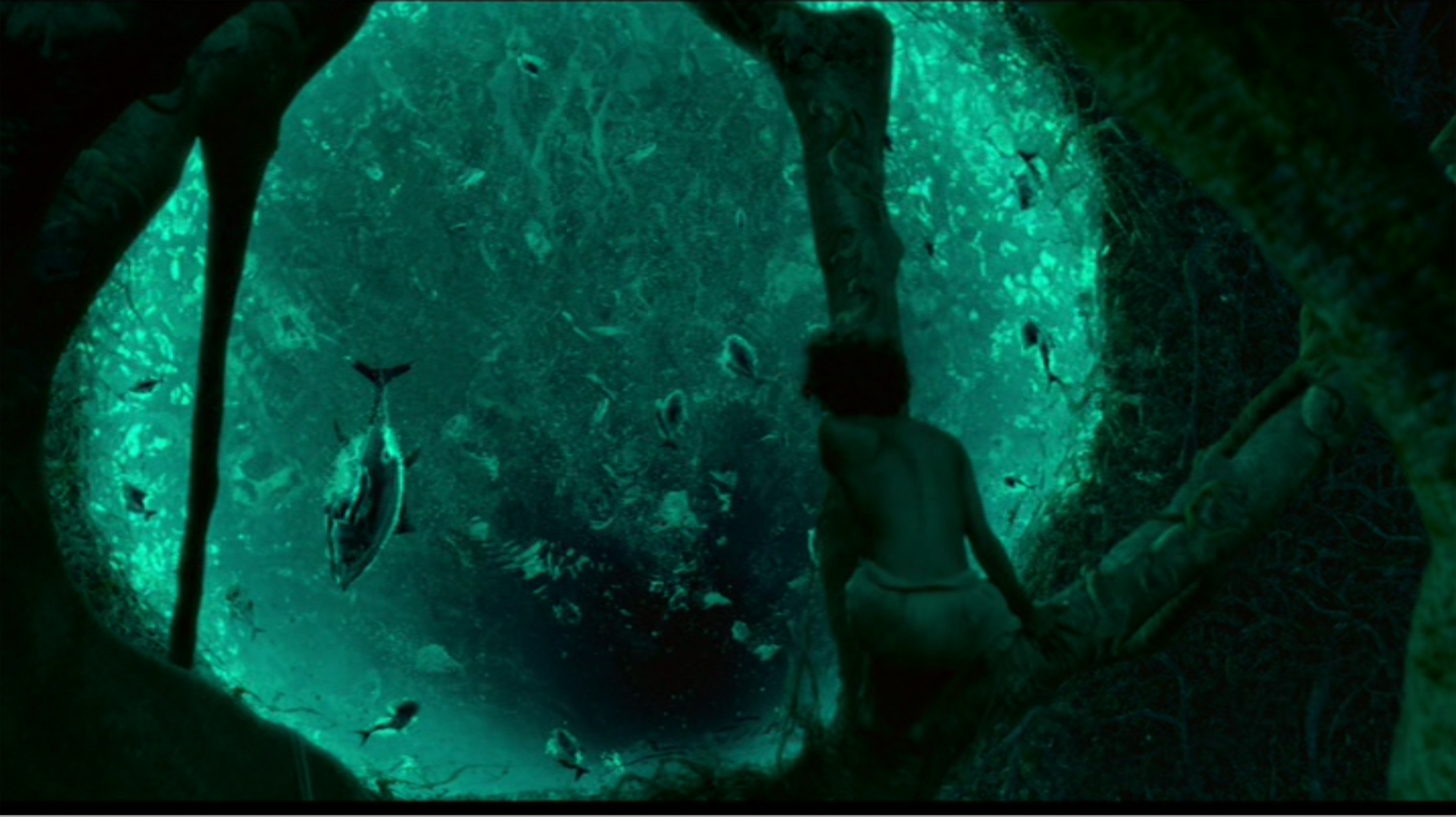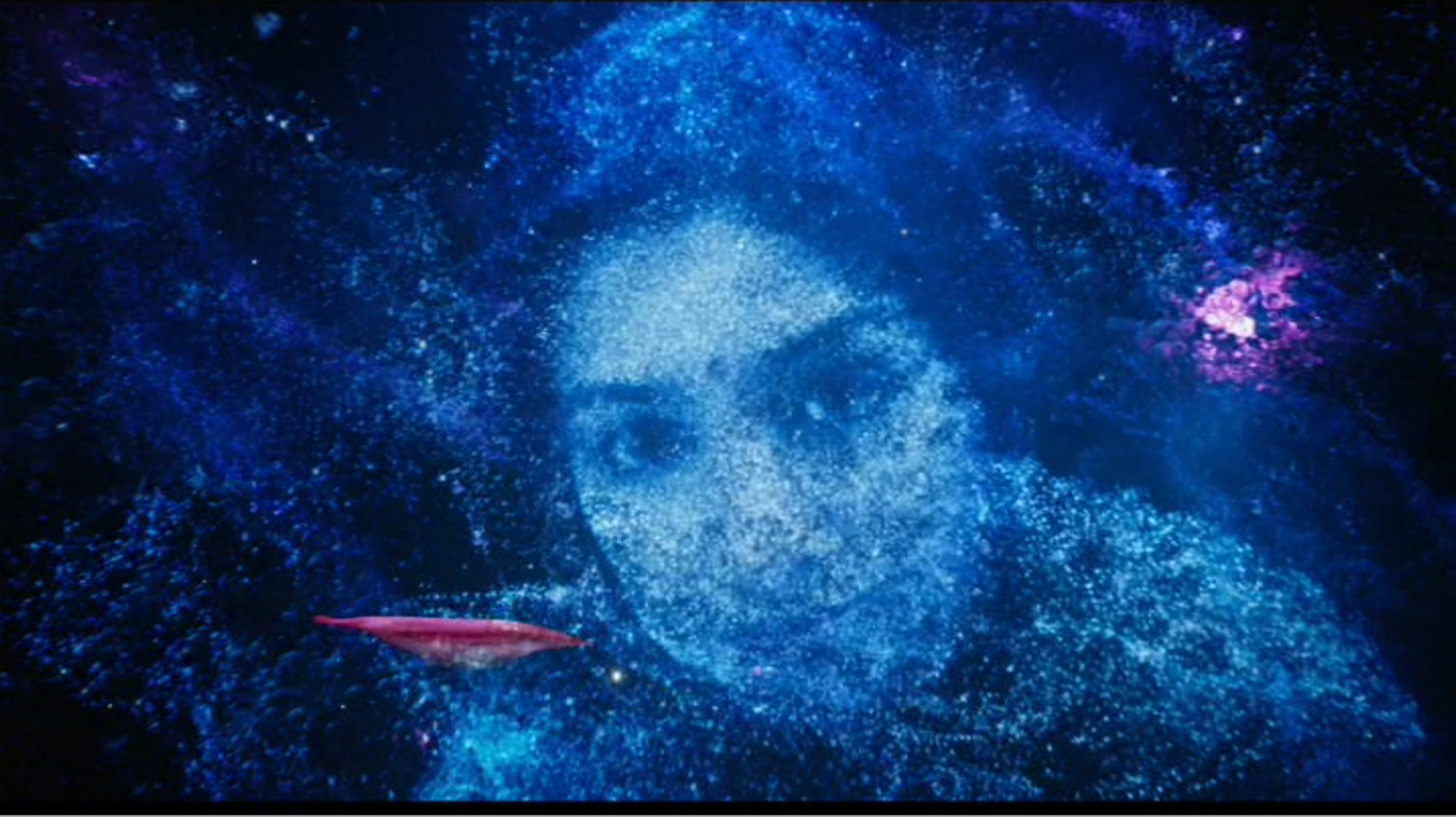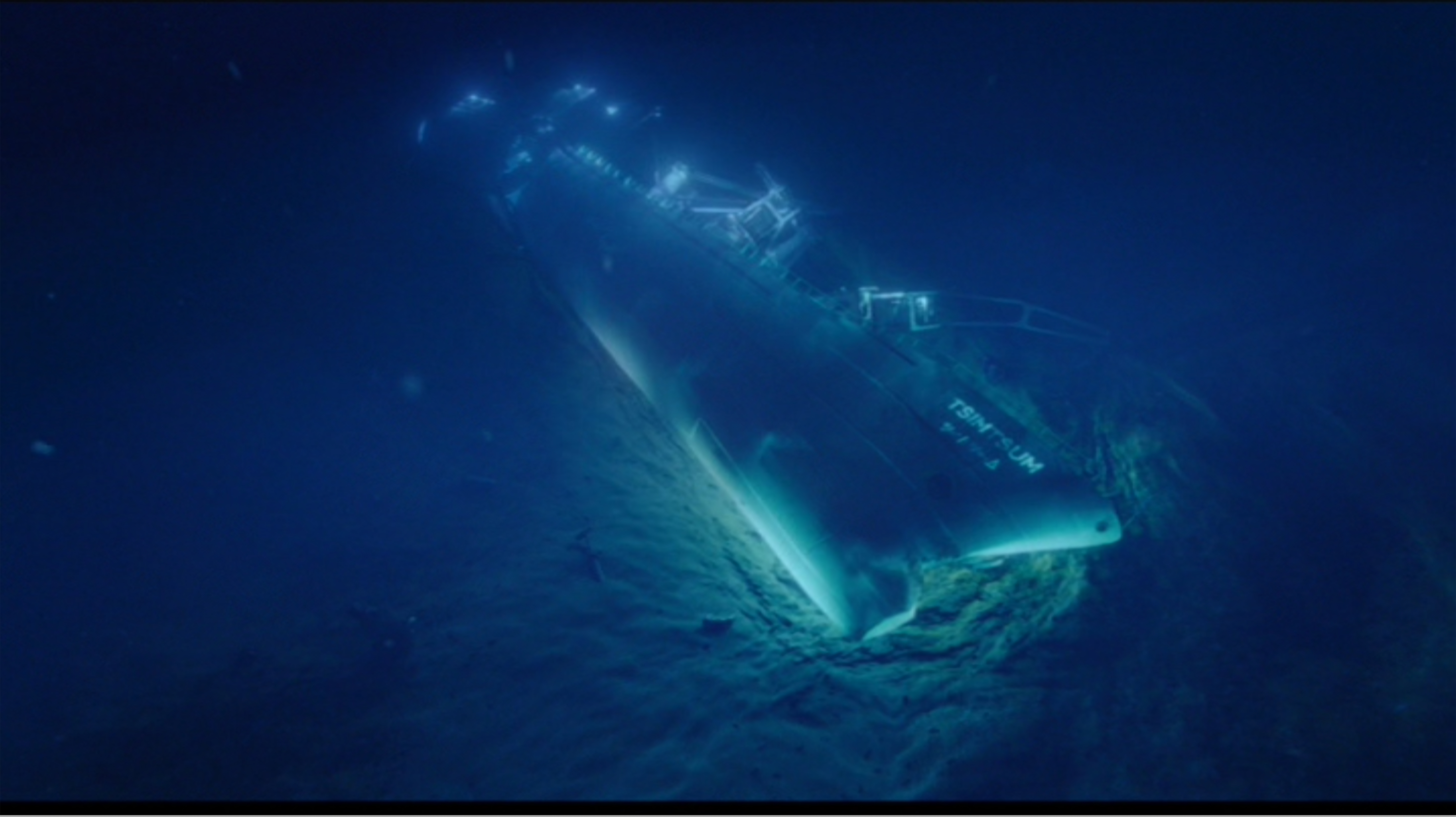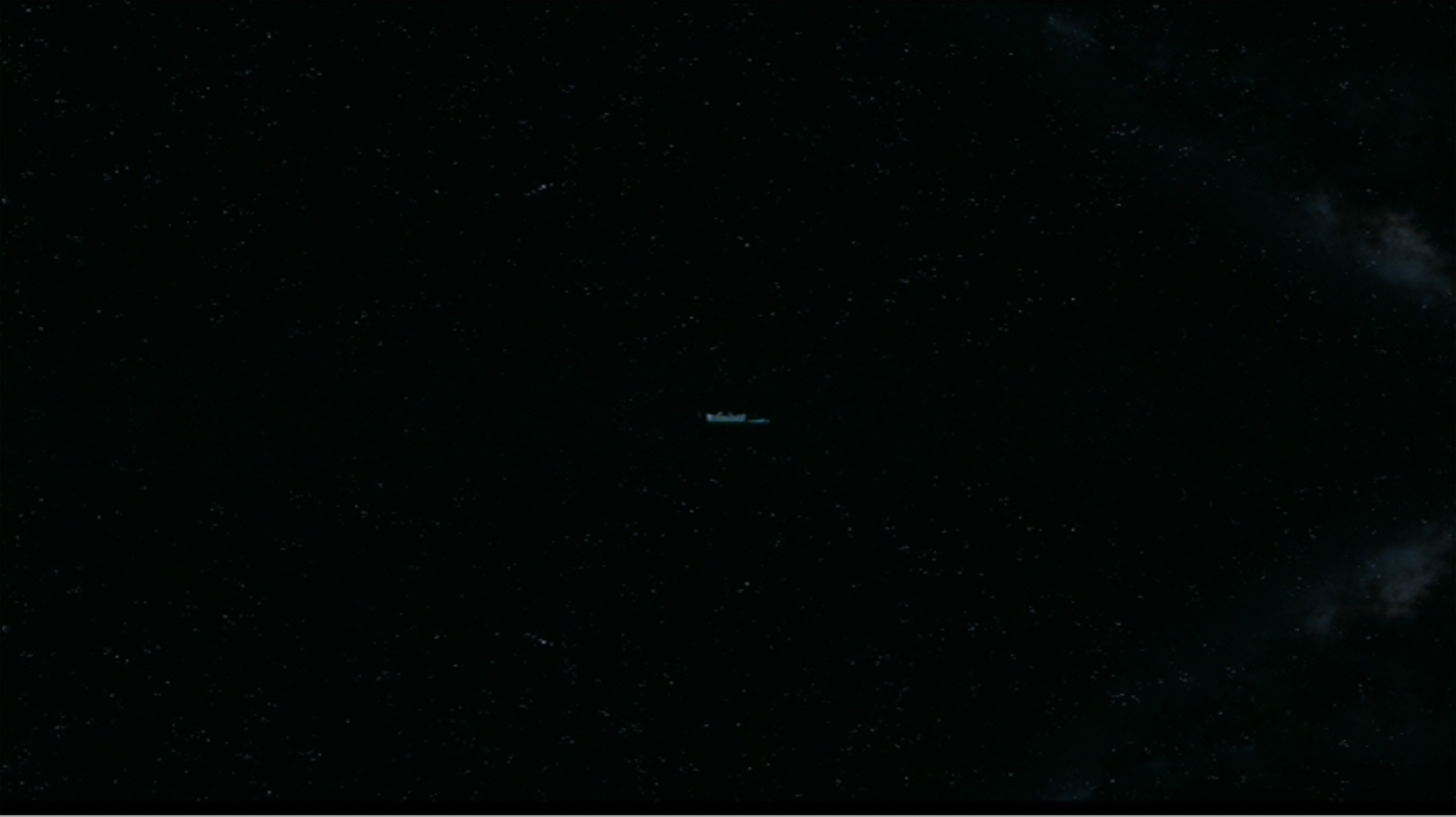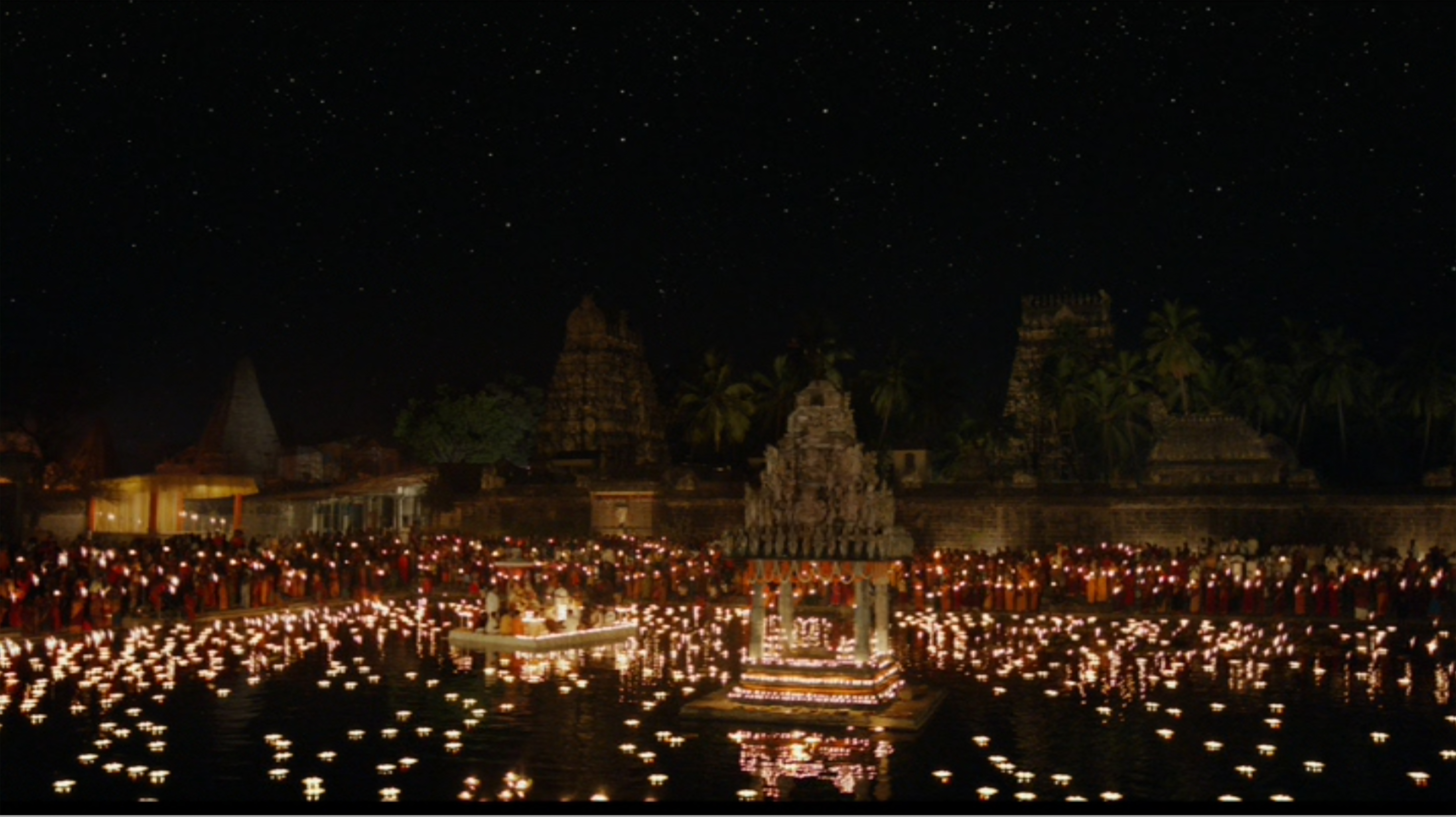Halfway through the extended flashback sequence that details its protagonist’s harrowing story of diasporic migration and shipwreck, Life of Pi (Ang Lee, 2012) stages a highly stylized visual effects set-piece that filters the virtual camera’s point of view through the nonhuman perspective of a computer-generated Bengal tiger and sends it plunging from a lifeboat to a sunken cargo ship (named the Tsimtsum, the sinking of which has left the protagonist and the tiger in a state of extreme precarity) lying at the bottom of the Mariana Trench. During the continuous long take that comprises its downward mobility, the virtual camera appears to summon forth and then dissolve a sequence of stylistically distinct and highly allusive spectacular displays in response to Pi’s demand to the tiger to “Tell me what you see.” Each display features objects and images retrieved and aggregated, so to speak, from earlier and later scenes in the film: a giant squid and a whale, locked in a life-or-death struggle, morph and fracture into a menagerie of zoo animals (giraffe, hippo, leopard, etc.) that float to the edges of the frame; the alluring bioluminescence of an anglerfish gives way to razor-toothed jaws and a body that disintegrates into white bits of light; pixelated bioluminescent plankton swirl in the darkened depths, creating an allusive archive of various light forms that appear elsewhere in the film; a Kolam flower, spinning among neuron-shaped nebulae, morphs into an ethereal closeup of the protagonist’s mother, which the camera’s proximity decomposes into electronic signals; and, finally, after passing through the glimmering passage of a fiber-optic cable, the virtual camera reaches the shipwrecked Tstimtsum before returning to the lifeboat and the reflected image of Pi, astonished by what he has seen.
In an act of underwater archaeology, the virtual camera takes up Derek Walcott’s assertion that “the sea is history”1 and plunges into the abyss to produce, through the artefactual displays it composes and dissolves, its own deep reading of the various crises that define both the fictional world of the film and the broader industrial context in which the sequence was produced. In what follows, I argue that Pi’s movement from Pondicherry to cargo ship to lifeboat, and the camera’s movement from tiger to shipwreck to Pi, trace out the broader historical drift into “liquid modernity.” This condition, which, as Zygmunt Bauman argues, arrived in the 1970s with the regime of flexible accumulation, has only intensified in the 21st century thanks to the ongoing disintegration of various institutions and protections that once provided the individual with a modicum of socio-economic stability—a comparatively solid (however shaky) ground on which one might withstand the blows of fate and erratic market forces.2 Precisely by making its highly allusive, abstract spectacles inseparable from downward mobility (and it must be thought of as such, both in the literal sense of directionality and in the figurative, economic sense), the virtual camera brings into view the place of the cinema’s digital turn within liquid modernity and affords the opportunity to think through the relationship between aesthetics and labor, visual effects and political economies.
The virtual camera’s simulated movement is central to this argument. Itself an elaborate visual effect, the virtual camera’s directional “motion,” its surface-to-ocean floor trajectory, structures the perception of each spectacular display through and as a constitutive element of a figural “transnational ‘race to the bottom’”3 that traces out the downward economic mobility attending processes of globalization, and gives spectacular expression to the (invisible) forces of late capitalism that plunge the world headlong toward catastrophe. Insofar as the virtual camera appears to initiate the composition and decomposition of a series of spectacular displays, its simulated movement is agential: virtual camera movement becomes visible as a creative force that is, simultaneously, inseparable from dissolution. This aesthetic of dissolution is commensurate not only with the “processual” aesthetic of the digital image (one that references the technical substrate and computational processes that generate digital images) discussed by Shane Denson4 and Jordan Schonig,5 but also with the experience of liquid modern life, and it finds articulation through the fluidity of the (digital) oceanic setting.
Yet the sequence pushes beyond self-reflexivity to connect its spectacles to the consequences of late capitalism by inscribing virtual camera movement within globalization’s broader infrastructural, technological, and elemental assemblage—a vast “ecosystem” that normally exceeds human perception. In turn, by diving through oceanic depths, virtual camera movement brings the ocean into view as what John Durham Peters,6 Erika Balsom,7 Christina Sharpe,8 and Melody Jue9 have theorized as an elemental, affective medium (that stores, displays, circulates, dissolves), as a mediated ecosystem that has historically functioned as a “conduit of the colonial project”10 and of global flows (of information, labor, commerce, populations, and capital), as a force of contingency capable of disrupting such flows with catastrophic consequences, and as an archive of human wreckage. The sequence elaborates the idea that the digital visual effect is not simply a form whose medium-specific properties allow it to represent dissolution and liquidity so spectacularly; rather, through its race to the bottom, the virtual camera not only activates a metaphor for the declining conditions and downward socio-economic mobility experienced by a globalized workforce (including visual effects labor), but also makes its own virtual movement visible as a symptom of and proxy for globalization’s liquidating effects.
Indeed, Life of Pi explicitly locates the origins of its fantastic story “with a tiger” in a tale about the grim fate of labor. The film is organized around an extended flashback sequence (narrated by an adult Pi to a novelist in search of a story), which focuses on Pi’s struggle to survive the sinking of the Japanese cargo ship that had been carrying his family and their zoo animals to Canada. In it, Pi ends up on a lifeboat along with an injured zebra, an orangutan, a hyena (which kills and eats the zebra and the orangutan), and a Bengal tiger (which kills and eats the hyena). The tiger remains onboard the lifeboat with Pi, who must contend with it along with the elements. After reaching shore, Pi is interviewed by shipping company representatives who refuse to believe his tiger story. Pi then recounts the true story in which an injured Buddhist sailor (the zebra) is killed and eaten by the ship’s French cook (the hyena), who also kills Pi’s mother (the orangutan) and is then killed and eaten by Pi (the tiger). The disclosure transforms the flashback into an allegory for a more terrible truth about labor’s cannibalization. Although he asks the novelist to choose which story he “prefers,” Pi’s shocking revelation makes the allegorical flashback indissociable from the horror it re-signifies.
If this is a story not least about labor, visual effects is part of it. Life of Pi seems to anticipate the fate of Rhythm & Hues (R&H), the visual effects company that laid off 254 workers and declared bankruptcy shortly before winning an Academy Award for the visual effects that it produced for Life of Pi itself.11 Left insolvent by the contingencies and endemic crises arising from Hollywood’s subordination of the visual effects industry to the regime of flexible accumulation, R&H was eventually purchased by one of its competitors, Prana Studios (India). As Julie Turnock emphasizes, in an industry where the cost of creating visual effects can easily exceed the fixed fee a company receives from a studio for its work, R&H’s history is commonplace.12 The “tiger vision” sequence (so dubbed by production and the artists at Buf Compagnie that designed and created it)13 allows us to see Pi’s struggle to stay afloat upon a computer-generated ocean as an allegory for creative labor’s struggle to survive in an era when (the production of) each visual effect brings with it the increased threat of financial dissolution, the risk of “going under.” Ultimately, the sequence suggests that, regardless of its aesthetic, in the era of globalization, the spectacular digital effect must be seen as an artefact of, and enmeshed within, a system of ruination.
Liquid Modernity and Labor’s Instrumentalization
Life of Pi’s flashback sequence begins in the early years of India’s independence and ends in 1977, when Pi and the tiger (named Richard Parker) wash ashore on the coast of Mexico. The film’s story of shipwreck and survival coincides with and allegorizes the historical shift to flexible accumulation14 in the wake of the 1972/3 economic crisis and globalization’s disintegration of socio-cultural, political, and economic barriers to the fluid mobility of capital. Bauman associates the shift to this new stage of capitalism with the onset of the “profound and in principle untamable uncertainty”15 that defines liquid modern life. He writes, the “1970s was the decade when the ‘glorious thirty years’ of postwar reconstruction, social compact and the developmental optimism that accompanied the dismantling of the colonial system and the mushrooming of ‘new nations’ was falling into the past, opening up the brave new world of erased or punctured boundaries, information deluge, rampant globalization, consumer feasting in the affluent North and a ‘deepening sense of desperation and exclusion in a large part of the rest of the world’ arising from ‘the spectacle of wealth on the one hand and destitution on the other.’”16
For Bauman, modernity’s liquid stage is inseparable from globalization’s intensification of key features of capitalism, resulting from the shift in power from nation states to global capital, and is exacerbated by the dissolution of the social structures, political institutions, and economic policies which had provided a modicum of “solidity” for citizens of Western nation states and emerging, decolonized democracies between 1945 and the early 1970s. These changes include: neoliberalism’s dissolution of the welfare state’s social safety net; deregulation; the separation of power from political institutions; the enervation of labor unions and the globalization of labor; the destruction of local/regional economies, family-owned businesses, and cultures; and the forced migration of millions.17 To this “set of dissolving assurances,” Lauren Berlant adds “upward mobility, job security, political and social equality, and lively, durable intimacy” and “the sense that liberal-capitalist society will reliably provide opportunities for individuals to carve out relations of reciprocity that seem fair and that foster life as a project of adding up to something.”18 The erosion of “state built and state-serviced defenses against existential tremors” and the weakening of the trade unions preclude, for Bauman, “the possibility of existential security which rests on collective foundations.”19 Such change gives rise to a world “in which each individual is left on his or her own while most individuals are tools of each other’s promotion.”20 In turn, the linear “progress” that (for better or for worse) structured an earlier stage of modernity has given way, Bauman argues, to the anticipation of the next inevitable crisis, which the individual must face alone using “short-term stratagems” and “resources that are blatantly inadequate to the task” at hand,21 all while inhabiting the “flexibility” required to pursue “opportunities according to their current availability.”22 In liquid modernity, “being treads water”23 as “extensive threats to survival… dominate the reproduction of life.”24
The conditions under which visual effects artists conduct their creative labor offer a glimpse into the experience of liquid modernity. As Michael Curtin and John Vanderhoef, Leon Gurevitch,25 Julie Turnock,26 and Hye Jean Chung27 have shown, the precarity of visual effects labor has arisen from Hollywood’s globalization of labor, whereby studios “offshore” effects work, often in piecemeal fashion to numerous companies, in pursuit of tax subsidies that benefit the studios (not visual effects companies) and the promise of cheap labor and low overhead costs (in Mexico and China, for example). The harnessing of visual effects production to the regime of flexible accumulation has resulted in declining work conditions around the world and the collapse of numerous effects houses. Companies secure work through the project-bid system, which forces them to compete on the global marketplace for fixed-fee contracts that do not provide overages to cover costs arising from the contingencies that beset all productions (such as production delays, requests for changes, and human error), making insolvency and bankruptcy commonplace within the industry.28 Because independent effects houses do not share in box office revenue, they may struggle to stay afloat even when contributing to a string of prestigious box office hits; securing a large contract on a prestigious film may, in the end, cause a company to go under.29
Such conditions generate “untamable uncertainty” for visual effects workers, who inhabit the “new liquid modern ‘permanently transient’ pattern of life.”30 Artists are hired on short-term contracts on a per-project basis, making employment unpredictable and periodic unemployment inevitable, all while demanding frequent relocation to globally dispersed worksites.31 Unprotected by guilds or labor unions, artists work at least ten to twelve hours a day, seven days a week (one artist explains that when she became pregnant, she was allowed to “work eleven-hour days instead of twelve, and six-day weeks instead of seven”),32 without benefits or overtime. If an effects house runs out of money or if a production shuts down, artists may not be compensated for work they have already completed.33 Such conditions prevail around the globe (R&H itself had satellite offices in India, Malaysia, Taiwan, and Canada). As Curtin and Vanderhoef explain, while “artists in United Kingdom and Canada worry that they too will lose their jobs if industry subsidies from their governments evaporate,” those in “Mumbai and Shenzhen face persistent pressure to pare back their already lean paychecks… hard deadlines, managerial pressure, cramped conditions, long hours, and short-term contract positions are shared across territories.”34
Turnock attributes the willingness of creative artists to remain in a profession characterized by perilously “low profit yields and high risks” to the “romanticized notion of creative labor”35 which pervades industry discourse, promotional materials, and fan culture and promotes “the fantasy of working for an idolized cinematic visionary such as George Lucas and contributing to a Star Wars-size impact on the cultural landscape.”36 This fantasy seems shot through with neoliberalism’s “cruel optimism,” the “affective structure” and “optimistic attachments” of which, Berlant argues, involve
a sustaining inclination to return to the scene of fantasy that enables you to expect that this time, nearness to this thing will help you or a world to become different in just the right way. But, again, optimism is cruel when the object/scene that ignites a scene of possibility actually makes it impossible to attain the expansive transformation for which a person or a people risks striving; and, doubly, it is cruel insofar as the very pleasures of being inside a relation have become sustaining regardless of the content of the relation, such that a person or a world finds itself bound to a situation of profound threat that is, at the same time, profoundly confirming.37
Despite the constraints of the project-bid system, each new temporary contract “ignites a scene of possibility” in which proximity to this or that auteur or franchise might result in increased stability, adequate compensation, and cultural capital. Yet as scholars and effects artists have explained, Global Hollywood’s38 resistance to altering the downwardly mobile trajectory of visual effects labor institutionalizes precarity and creates structural barriers to collective action. In liquid modernity, visual effects work is the art of staying afloat and a labor of survival.
Life of Pi envisions, however abstractly, the place of the computer-generated image, and the labor that produces it, in liquid modern life. In the film, spectacular digital effects mediate contingency, and, again and again, their appearance signals the inescapability of “profound and in principle untamable uncertainty.” In the film, liquid modernity arrives with the political crisis that threatens the survival of the Pondicherry Zoo—a family business created in partnership with the local town council to commemorate independence from France. While Santosh owns the zoo’s animals and runs the business, the town council owns the land. The Emergency (referenced briefly in a radio broadcast reporting on censorship, mass arrests, and state violence) threatens to dissolve the Patels’ reciprocal relationship with local government and, with it, the very ground beneath their feet. The zoo is one of many socio-cultural formations (including the school, temple, mosque, pool, church, and family home) connecting Pi to the “dense and tight network of social bonds”39 that characterizes the postwar era of decolonization of Pi’s childhood—connections that begin to dissolve in the Emergency’s wake. In an effort to counter the uncertainty that arrives with political crisis, the Patels pack up the material remainders of their “good life” and board a cargo ship so that their animal assets can be sold on the global marketplace. Embarkation onboard the Tsimtsum (a Japanese cargo ship staffed by an international crew) amounts to permanent absorption into the “new liquid modern ‘permanently transient’ pattern of life.”40 Once they enter the “non-place” (to borrow a term from Marc Augé41) of the commercial shipping lane, Pi and his family are subject, without any of the protections of home, to global capital’s deterritorialized power.
Life of Pi takes seriously the notion that, as Peters argues, the ship materializes “the original meaning of metaphor” insofar as it is “a vessel or vehicle that transports passengers and cargo from one place to another”42; the cargo ship (which is not a container ship, signaling its age and its circulation on the periphery of the global economy43) is the perfect vehicle for transporting Pi from one stage of modernity to another, from security to precarity, and for placing him upon the “transnational trajectory” that forces him to navigate “the hegemonic power structures that pervade histories of the diaspora, colonialism, postcolonialism, and globalization.”44 If, as Peters argues, each ship is “an allegory for civilization”45 that “makes features about social order visible,”46 then embarkation onboard the Tsimtsum not only signals entry into globalization’s circulatory networks but, moreover, lays bare the distinguishing features of this political economy’s “social order.” Life onboard the Tsimtsum is governed by a form of biopolitical power that finds articulation through the racialization of consumption: the ship’s French cook withholds food from both Hindu and Buddhist passengers and the members of crew who hail from nations formerly colonized by France and Japan. Shouting at Gita, who has asked for vegetarian food, the cook equates the ship’s vegetarians with animal herbivores (“The cow that produced this liver was vegetarian. The pigs that went into this sausage were vegetarian”), a discursive violence that reclassifies Pi, Gita, and the sailor as nonhuman, as natural resources. The social order made visible by the cargo ship demands individual solutions to the problem of survival: while Santosh later reassures Pi that they can procure supplies at the next port, the Buddhist sailor adopts the “flexibility” demanded of labor by global capital: “Onboard [the] ship,” he explains to the despondent family, “gravy is not meat. [It] is flavor.”
In Life of Pi, absorption into liquid modernity is irreducible to the film’s aquatic setting. The film’s digital ocean is a site where contingency and chance hold sway and overwhelm all else, producing the untamable uncertainty registered by the (felt) absence of any “ground.” The final dissolution of the latter is decisively rendered by the image of shipwreck, precipitated by a massive rogue wave that swamps and floods the Tsimtsum’s lower deck (figure 1). The computer-generated wave animates the cinematic figure for contingency par excellence, one that, as Mary Ann Doane,47 Dai Vaughn,48 and Jordan Schonig49 have discussed in detail, fascinated audiences of early actuality films such as Barque sortant du port (1895). In that film, observers standing on a jetty watch as a rowboat makes its way out to sea in choppy waters; as the film ends, a large wave lifts the boat, leaving its fate uncertain. Shot from the camera’s secure position onshore, the film creates a pleasurable dialectic between the uncontrollable, the fluidly unpredictable, and the precarious, on one hand, and the stable, the solid, and the secure, on the other. A proxy for the audience, diegetic observers inscribe and, in the process, shore up the grounded position from which the camera records the ocean’s uncontrollable power and unpredictability. Animated rather than recorded, Life of Pi’s digital wave maintains a relation to the contingent motion of water thanks to the “peculiar ontological structure” of particle animation software programs, which, Schonig explains, “integrate an element of the random into otherwise highly calculated systems” thereby uniquely embodying “the peculiar nature of the phenomenon they simulate.”50 Once it washes away the grounds on which Pi stands to observe it, the digital wave becomes an allegorical image for the dissolution of the “fixed or grounded observer of the single point of view as predicated by the last five hundred years of monocular perspective.”51 Such dissolution finds expression through the 3D image of Pi, submerged below the ocean’s surface to avoid another rogue wave, floating into the space of exhibition as the still-illuminated ship sinks into the horizonless darkness of oceanic depths (figure 2)—a shot that correlates digital 3D cinema’s immersive aesthetic with absorption into liquid modern life.
As this shot suggests, in Life of Pi, the natural and the economic are not simply parallel forces of contingency; they are joined together in the spectacular digital effects that function as allegorical images for the dissolution that accompanied the historical shift into liquid modernity. By mediating its fictional past in this way, the film’s spectacular digital effects charge with affect the historical conditions that persist in the (film’s) fictional present and that shaped the film’s production. For example, one nighttime sequence opens with the sublime image of Pi floating on a vast ocean surface illuminated by blue bioluminescent marine life. As Pi splashes the water to create more light, a whale (jaws wide open) breaches the surface and smashes back down, overturning the raft and sending Pi’s food supplies overboard. The breaching whale is a figure for the uncontrollable force of contingency which breaks (spectacularly) into view without warning. Removed from the lifeboat and carefully inventoried by Pi, the lifeboat’s supplies had added up to a quantifiable (if grim) future that dissolves once the provisions are dumped into the sea. In the next sequence (which begins with the voiceover, “Hunger can change everything you ever thought you knew about yourself”), the lifeboat drifts by chance into the path of a school of flying fish, prompting a violent struggle over scarce resources that provide a temporary solution to the long-term problem of survival. In Life of Pi, precarity and uncertainty are the stakes of the visual effect’s spectacular arrival on the scene, stakes that are applicable to the production context for each sequence.52 Making use of a felicitous coincidence between image and industry parlance, we can note that under the competitive bid system, “landing the whale” (a term used for securing a major project53) may give rise to groundbreaking visual effects that cause a company to incur catastrophic losses; in turn, as in the flying fish sequence, the unpredictable arrival of insufficient and difficult-to-capture resources (like the piecemealing of effects works to numerous houses) provides a short-term solution to the persistent problem of remaining solvent and staying afloat.
The digital effects that give chance, contingency, and crisis sway over each sequence (and thereby emblematize the conditions of their own production) also mark the spectacular return of the true story of labor’s cannibalization allegorized by the fantastical flashback.54 Before it disappears, the cargo ship delivers Pi to another vessel that intensifies the experience of existential precarity. A fragment of the Tsimtsum, the lifeboat “creates its own world afresh,”55 one that is strictly organized around a racialized “structural antagonism” created by the cook’s earlier classification of South and East Asian Hindu and Buddhist vegetarians with animal herbivores, producing onboard the lifeboat a racialized “‘species’ division between what it means to be a subject and what it means to be an object.”56 In other words, the flashback which, on the surface, appears to be a (rather neoliberal) story of the individual’s ultimately successful struggle to survive against all odds, is in fact an allegory for the racialized instrumentalization of globalized labor.
Onboard the lifeboat, we learn, the cook sets about extracting resources from this new environment, transforming his fellow survivors into tools for his own survival and into objects of consumption. Putting Gita and Pi to work, he enlists them in the gruesome task of amputating the sailor’s broken leg—not to save his life (as the cook initially pretends), but to reduce the sailor to the value (i.e., calories, bait) that can be extracted from his flesh. In short, the cook transforms labor into the matter of “necropower’s” survival, forcing Pi, Gita, and the Buddhist sailor to endure “new and unique forms of social existence” that confer upon them “the status of the living dead.”57 Gita slaps the cook when he lets slip that instrumentalizing the sailor’s flesh was the point of the amputation all along. When the cook beats Pi for allowing a sea turtle to slip away, Gita pummels him; infuriated, he stabs her and feeds her to the sharks. In an act of anticolonial resistance, Pi kills the cook and, succumbing to starvation, eats his remains. The tiger that emerges (literally, in stereoscopic 3D, from beneath the lifeboat’s tarp and across the threshold of the screen to kill the hyena) can thus be read as an effect of global capital’s predatory power and its instrumentalization and cannibalization of labor.
Insofar as the tiger mediates life and death onboard the lifeboat, it adheres to the conventions used to vitalize (i.e., embody, charge with biological processes as well as sensation) creatures that are pure information; the tiger seems convincingly alive not simply because of the (hyper)realism of the computer-generated image, but also because it constantly threatens, and is threatened by, death.58 Yet the tiger exceeds this general tendency of digital creatures by serving as a symptom of the textually repressed fact of cannibalism that condemns the sailor to death and, as a form of resistance to the French cook’s racialized violence, enables Pi to live. If, as Peters argues, “the morphological and functional range of living animals” must be perceived as “a historically sedimented set of solutions to the problem of existence,” then the Bengal tiger emerges on the lifeboat as a figuration of the “historically embedded answer” to “the question of how to be in [a] world”59 in which the postcolonial subject has been transformed into an object to be devoured by the neo-imperial forces of late capital.60
The fracturing of Pi’s subjectivity into “skinny vegetarian boy” and flesh-eating tiger enables him to attempt to tame and eventually disavow the form of violence that his resistance takes. At the same time, this taming process transforms the boat into a scene of possibility that keeps a remainder of the past “alive” (i.e., the zoo as a commemoration of Pondicherry’s independence from France, his father’s lessons) so it might endure, phantasmatically, in the present. Cruel optimism binds Pi affectively to the tiger and, with it, “to a situation of profound threat that is, at the same time, profoundly confirming”: while the tiger is the “terrible one” whose care, Pi explains, keeps him alive by giving him “purpose,” it also forces him onto the more precarious raft and poses the constant threat of death. Precisely because the same cruel optimism structures visual effects work and binds the artist affectively to the spectacular digital effect, the image of the live action protagonist tethered to the digital tiger emblematizes the structural precarity characterizing visual effects labor in Global Hollywood. The digital tiger is, in other words, a figure for the “in principle untamable uncertainty” and existential anxiety that stalks the individual in liquid modernity.
The Virtual Camera’s Race to the Bottom
Following a scene in which a ship passes by in the distance, oblivious to Pi’s rescue flares, the tiger vision sequence opens with a jarring establishing shot of the lifeboat, which juts out from the bottom edge of the frame and seems to float within a cosmic void (figure 3). The dark night sky reflected on the water’s smooth surface contrasts sharply with the brightly lit boat, and the camera’s slightly elevated angle flattens the boat, transforming it into a platform for staging an act of highly mediated perception. Filtering its vision through the tiger’s, the virtual camera’s downward trajectory promotes an approach to the film that reads the elements and economics, the animal and capital (along with the contingency that characterize each) together. Structured as a deeply historical reading of the film’s digital ocean, the virtual camera’s “race to the bottom” brings the ocean into view as an elemental database of that which has been dissolved in liquid modernity. Its volitional movement registers as a search for and retrieval of the (textual) artefacts which, when composed into emblematic displays, might make such dissolution legible, interpretable. Oceanic and digital liquidity converge in the aesthetic of dissolution, such that camera movement itself seems to summon forth and then disintegrate each artefactual display. This aesthetic alludes to the processual nature of the digital image while defining virtual camera movement as agential, as the articulation of a (creative) force that is inseparable from dissolution, and its downward movement appears as an expression of the various forces and crises that define the fictional world of the film and the broader historical context within which the sequence was produced.
Filtered through the nonhuman perspective of the digital tiger, the virtual camera promises to render visible that which exceeds human perception. As it plunges past the reflected image of Richard Parker into darker z-axis depths, the virtual camera appears to call forth a fantastical, abstract image of the liquidation of the Pondicherry Zoo in a manner that insists upon the inseparability of the oceanic and the economic. The display takes shape as a giant squid surges from behind the camera and dives down toward a whale that emerges from the darkness. The squid and the camera (aligned with one another by virtue of their movement) pause briefly and, as the whale swims past, the squid attacks it, wrestling it into the center of the frame. Struggling, the creatures morph into a cluster of zoo animals and marine life which breaks apart (figure 4) as the camera resumes its race to the bottom, creating a decidedly computational image of dissolution that is inseparable from liquid modernity.
Giving abstract expression to late capitalism’s liquidating effects, the virtual camera folds its own movement into the long (colonial) history of the technological mediation of wild/marine life and the circulation of “exotic” animals (as commodities, as images, as tokens of empire) around the globe. The zoo, the aquarium, and the natural history diorama: these made wildlife displays an integral part of (colonial) modernity’s urban commercialized leisure. In Life of Pi, the morph’s dissolution of the boundaries separating species thematizes the historical shift toward wildlife’s mediation as immaterial information, as digital visual effects. At the same time, it gives formal expression to the zoo animals’ (historical) liquidity—to their transformation from physical displays to assets liquidated into capital—and to their equivalence and interchangeability on the global marketplace as objects of exchange. In turn, the submarine menagerie provides a fluid image of the ocean’s mediation of the global circulation of “wildlife” as a material and immaterial commodity. While liquidity becomes visible, in this display, as a property, liquidation appears as a form of historical transformation through which to read Pi’s fate. The submarine menagerie gives abstract representation to the “dissolution of optimistic objects/scenarios”—the zoo as family business, the animals as surplus value to finance a new life—“that had once held the space open for the good-life fantasy.”61 The virtual camera does not stand apart from the scene it envisions62; rather, its coordination with the squid and the dissolution resulting from its race to the bottom inscribe it as an agent that makes and unmakes the surreal scene it brings into view.
If the first display synthesizes the virtual camera’s downward mobility with various forms of liquidation, the next rehearses the relations of cruel optimism that attend liquid modernity and uses the camera’s directionality to stage “the transformation of what had seemed foundational into those binding kinds of optimistic relation we call ‘cruel.’”63 The camera plunges past animals that float out to the edges of the frame and toward a small circle of light appearing in the center of the screen. A deadly lure, this light is attached to, and provides cover for, the jaws of an anglerfish (figure 5). Alluding to the alluring light and open jaws of the breaching whale sequence, the anglerfish’s bioluminescence initially “ignites a scene of possibility” by promising something other than darkness or the fate of being eaten alive. The species’ morphological structure gives form to the complex set of relations that structure the effort to live within liquid modernity: the dorsal ray that tethers alluring light to certain death materializes the “optimistic attachment” that binds one affectively to “a situation of profound threat that is, at the same time, profoundly confirming.” In this respect, it is a biomechanical figure for the rope (and the affective attachment) that tethers Pi’s makeshift raft to the lifeboat and to Richard Parker. The camera’s rush toward the light it summons from the depths enacts the optimistic movement of vulnerable prey and rehearses an irresistible return to “the scene of fantasy” that fosters the expectation that “this time, nearness to this thing”—alluring light and all it promises—“will help you or a world to become different in just the right way.” Maintaining the sequence’s processual aesthetic of composition and decomposition, the anglerfish disintegrates into pixelated light as the camera glides past, again making camera movement visible as a force of dissolution and the computational image a constitutive element of liquid modernity’s dissolving assurances. Given the source of this “vision’s” enunciation (an elaborate digital creature), it seems reasonable to include visual effects labor within the cruelly optimistic “scene of fantasy” emblematized by the anglerfish (this time, nearness to this particular production or that particular digital asset will transform this form of creative labor into something reciprocal, viable, rewarding).
Virtual camera movement dissolves the fish into an archive of light forms that appear in earlier and later scenes to underscore the abandonment of the individual to chance and the impossibility of rescue in liquid times. Bioluminescent plankton form red-orange swirls, referencing the signal flares that, in the preceding scene, Pi shoots into the sky as a passing ship disappears into the horizon. Initially promising salvation, the flares ultimately underscore the invisibility and insignificance of Pi’s plight to globalized power and the subordination of his fate to contingency and chance. In turn, while blue bioluminescent plankton reference the breaching whale scene, bits of green bioluminescence reference the deadly lure of a floating island’s later promise of rescue. Composed of a webbing of edible roots and pools of fresh water, the island appears as a fantastical materialization of the social safety net and its path intersects with the lifeboat’s just as starvation seems inevitable. At night it becomes carnivorous and dissolves its prey in green bioluminescent acid, its glowing light signaling the transformation of all life into a consumable resource and the island’s “safety net” into a technology of extraction (figure 6). Light is liquidation in this scene, and bioluminescence illuminates a relation of power which, within the terms of the allegory, is not simply biological (i.e., a relation of predator to prey) but, like the unseen (or ignored) signal flares, must be read as a figure for the biopolitical—one that connects the film’s trope of predatory orality to dissolution. The camera’s volitional movement into this allusive submarine galaxy gives expression to the desire for immersion within rescue’s alluring scene of fantasy even as the inexorable linearity of its race toward ruin suggests that its fulfillment is a structural impossibility in liquid modernity.
With this in mind, it matters that the final stage of the virtual camera’s movement makes the ocean visible as an archive of human wreckage through images of globalization’s techno-elemental assemblage. The final digital spectacle displays self-reflexive images of Pi’s past as the virtual camera plunges through a web of nebulae toward a spinning Kolam flower that morphs into an image of Gita. Moving into an extreme closeup of Gita’s face (which evokes an earlier shot of Gita smiling at her children as they watch her decorate a Kolam flower), the camera passes through her bindi into a cable-shaped passage that terminates at the shipwrecked Tsimtsum. Drawing upon the cultural association of oceanic depths with the past, the virtual camera moves through a spectacle that fluidly represents the ocean and the digital as mediums intertwined in their support of globalization’s circulation of information, commerce, and bodies. Both facilitate such circulation and store historical traces of its disastrous consequences—a notion expressed through the display’s component parts and motion. While bubble-formed nebulae evoke the neural networks responsible for human memory and artificial intelligence, the flower’s clockwise rotation evokes a buffering GIF that asks us to wait for an explicitly processual image of Gita to be retrieved and assembled by the codec. The camera’s movement into an extreme close up of Gita decomposes the image into information encoded as light (figure 7), offering, as Garrett Stewart notes, a “trope…of dissolution per se,” and “an optical allusion to pixelation itself.”64 Passing through Gita’s bindi, the virtual camera appears to enter a cable composed of light, and its movement becomes visible as the “signal traffic”65 that flows through undersea networks of fiber-optic cables. The dialectical synthesis of virtual camera movement and spectacular display makes flexible accumulation’s normally invisible technological-elemental assemblage visible as such; yet this assemblage becomes visible only through images of profound loss, of the devastating human and material consequences of the political economy that it supports.
Upon reaching its destination—the shipwrecked Tsimtsum, lying on the ocean floor and bathed in cruel optimism’s bioluminescent light—the virtual camera reveals how the transnational race to the bottom always ends. As a part of globalization’s technological-elemental assemblage, the Tsimtsum becomes newly visible as an affective medium of and for global circulation—affective because of the scene of fantasy its circulation had promised (the “good life” that might be rebuilt overseas) and the liquidation that is the ultimate consequence of that movement. As a token and a casualty of the contingent forces and crises that are endemic to globalization, the cargo ship appears as late capitalism’s wreckage, archived in oceanic depths accessible only through nonhuman means. As the final image within a series of spectacular allegorical images, the cargo ship’s inert form gives mute expression to the idea that, in the fictional world of the film and in the era of Global Hollywood, the spectacular digital effect is—regardless of content—emblematic of ruin.
Moving beyond self-reflexive allusion to the medium specificity that enables the illusion of its “transcendent” mobility,66 virtual camera movement articulates an allegorical image of the broader conditions of its own possibility by inscribing its movement within, and as the spectacular expression of, a historical assemblage of technological, economic, and elemental forces that has dissolved the (geographical, political, trade) barriers that once constrained the movement of information, labor, commerce, culture, and capital. The line traced by the camera’s digital flythrough from the sunken ship back to the floating lifeboat maintains a clear connection between the two that emphasizes less a simplistic cause-effect logic (i.e., Pi loses everything because of the shipwreck) than a connection that underscores the ongoing, shared conditions that determine the fate of both vessels and all onboard. That is to say, the surface-ocean floor-surface movement emphasizes that despite the good fortune of having survived the shipwreck, the struggle to remain afloat—with fewer resources and diminished odds for success—persists. By insistently foregrounding the algorithmic origins of the camera’s downward verticality (i.e., its status as a particular type of digital visual effect), the tiger vision sequence makes spectacularly visible the dialectical relationship between two technologies central to processes of globalization and the regime of flexible accumulation—the massive cargo ship and the computer—and the consequences of their material and immaterial flows.
Underscoring this connection, the sequence’s final shot—a wide shot of the lifeboat, tiny and floating in the cosmic void of the nighttime sky reflected on the ocean’s surface (figure 9)—references, in order to update for a new historical context, the final shot of the Diwali festival sequence from Pi’s childhood, which depicts a statue of a recumbent, floating Vishnu surrounded by candles and a crowd of observers (figure 10). An image of boundedness, the religious spectacle represents and contains both ocean and cosmos. In turn, the architecture that separates the human domain from the night sky materializes the protective enclosure afforded by “a dense and tight network of social bonds” and emphasizes the comparative solidity and containment—within a socio-cultural field, a family history (we learn that religion is Gita’s only connection to the family that cut her off for “marrying beneath her”), a municipality, a sovereign nation, and the Divine (“Vishnu sleeps on the cosmic ocean and we are the stuff of his dreams”)—characteristic of the final years of an earlier phase of postcolonial modernity coinciding with Pi’s childhood. The final shot of the tiger vision sequence repeats the visual trope of the cosmic ocean in order to void any socio-cultural grounding or any sense of boundedness; when seen in stereoscopic 3D, the boat appears to float among the stars, untethered even from the force of gravity. In the place of the temple architecture, a barely visible horizon line indicates nothing more than the thin seam where oceanic and cosmic voids meet. Articulated as the condition that arises from the dissolving effects of global capital’s race to the bottom, the stereoscopic 3D image of the individual alone in the void and adrift in a world that is almost without horizon emblematizes the condition of liquid modernity in the age of globalization.
If the flashback’s story “with the tiger” is an allegory for labor’s instrumentalization and the broader historical drift into liquid modernity, then it makes sense to approach the spectacular effects that structure the flashback as the return of the textually repressed, as images that give expression to the contingency, crisis, and the untamable uncertainty that characterize the era of globalization. In the tiger vision sequence, virtual camera movement does not simply bring such spectacular displays into view; rather, by harnessing its movement to the dialectical composition and decomposition of a series of effects, virtual camera movement becomes visible as an agent of the historical change and “dissolving assurances” its downward drive toward ruin emblematizes. Attending to virtual camera movement does not, in this instance, amount to an idealization of its “aspirations of fluidity, mobility, and transcendence over symbolic, technological, physical, and geographical borders.”67 Rather, as I hope to have shown, it is precisely the virtual camera’s smooth mobilization along the z-axis into impossible depths, the fluid visualization of its “motion” as a creative force of dissolution, and the inexorable directionality of its “race to the bottom” that articulate and expose the downward mobility that shapes experience, labor, and existence under the regime of flexible accumulation. In short, Life of Pi’s virtual camera movement allows us to see the digital visual effect as liquidly modern and to think through digital cinema’s role not only in shaping, but also in providing a means for addressing, the labor of survival in liquid modern life.
Acknowledgements
My thanks to Rosalind Galt, Isaac Hager, Dan Morgan, and Jordan Schonig for their valuable feedback on this article.
Notes
- Derek Walcott, “The Sea is History,” in Collected Poems, 1948–1984 (New York: Farrar, Straus, and Giroux, 1987). Walcott writes of the Middle Passage. ⮭
- Zygmunt Bauman, Liquid Times (Cambridge, UK: Polity Press, 2007), 1–10. I favor Bauman’s concept of liquid modernity over David Harvey’s postmodernity because it is more evocative of a particular experience of historical change as a felt process of dissolution. Bauman distinguishes this new phase of liquidation from the “melting” solidity of late 19th and early 20th century modernity thus: “Modern times found the pre-modern solids in a fairly advanced state of distintegration; and one of the most powerful motives behind the urge to melt them was the wish to discover or invent solids of—for a change—lasting solidity, a solidity which one could trust and rely upon and which would make the world predictable and therefore manageable.” Liquid Modernity (Cambridge, UK: Polity Press, 2000), 3. ⮭
- I borrow this phrase from Curtin, Michael and John Vanderhoef, “A Vanishing Piece of the Pi: The Globalization of Visual Effects Labor.” Television and New Media 16, no. 3 (2015): 220. ⮭
- Shane Denson, Discorrelated Images (Durham: Duke University Press, 2020). ⮭
- Jordan Schonig, The Shape of Motion: Cinema and the Aesthetics of Movement (New York: Oxford University Press, 2022). ⮭
- John Durham Peters, The Marvelous Clouds: Toward a Philosophy of Elemental Media (Chicago: University of Chicago Press, 2015). ⮭
- Erika Balsom, An Oceanic Feeling: Cinema and the Sea (New Plymouth: Govett-Brewster Art Gallery, 2018). ⮭
- Christina Sharpe, In the Wake: On Blackness and Being (Durham: Duke University Press, 2016). ⮭
- Melody Jue, Wild Blue Media: Thinking Through Seawater (Durham: Duke University Press, 2020). ⮭
- Balsom, An Oceanic Feeling, 43. ⮭
- Curtin and Vanderhoef, “A Vanishing Piece of the Pi,” 220. ⮭
- Julie Turnock, The Empire of Effects: Industrial Light and Magic and the Rendering of Realism (Austin: University of Texas Press, 2022), pp. 25–58. ⮭
- Jody Duncan, “The Calculus of Pi.” Cinefex 132 (January 2013): 79. ⮭
- On flexible accumulation, see David Harvey, The Condition of Postmodernity (Cambridge, MA and Oxford: Blackwell Publishers, 1990), pp. 141–200. ⮭
- Zygmunt Bauman, Liquid Times: Living in an Age of Uncertainty (London: Polity Press, 2007), p. 2. ⮭
- Ibid., 49. ⮭
- Ibid., 2–4, 10–14. ⮭
- Lauren Berlant, Cruel Optimism (Durham: Duke University Press, 2011), p. 3. ⮭
- Bauman, Liquid Times, 14. ⮭
- Ibid., 24. ⮭
- Ibid., 10, 14. ⮭
- Ibid., 3–4. ⮭
- Berlant, Cruel Optimism, 10. ⮭
- Ibid., 7. ⮭
- Leon Gurevitch, “The Straw that Broke the Tiger’s Back?: Skilled Labor, Social Networks, and Protests in the Digital Workshops of the World.” The Routledge Companion to Labor and Media (New York: Routledge, 2016), pp. 190–201. ⮭
- Turnock, The Empire of Effects, 25–58. ⮭
- Hye Jean Chung, Media Heterotopias: Digital Effects and Material Labor in Global Film Production (Durham: Duke University Press, 2017. ⮭
- Turnock, Empire of Effects, 31; Curtin and Vanderhoef, “A Vanishing Piece of the Pi,” 226, 232. ⮭
- Turnock, Empire, 50-58. On declining labor conditions for below-the-line workers, see Toby Miller, Nitin Govil, John McMurrin, Richard Maxwell, and Ting Wang, Global Hollywood 2 (London: Palgrave MacMillan, 2004) and John Thornton Caldwell, Production Culture: Industrial Reflexivity and Critical Practice in Film and Television (Durham: Duke University Press, 2008). ⮭
- Bauman, Liquid Times, 48. ⮭
- Curtin and Vanderhoef, “A Vanishing Piece of the Pi,” 224. ⮭
- “Mariana Acuña-Costa, VFX Artist,” in Voices of Labor: Creativity, Craft, and Conflict in Global Hollywood, eds. Michael Curtin and Michael Sanson (Oakland: University of California Press, 2017), p. 235. ⮭
- See especially, “Dave Rand, VFX Artist” in Voices of Labor: Creativity, Craft, and Conflict in Global Hollywood, eds. Michael Curtin and Michael Sanson (Oakland: University of California Press, 2017), pp. 216–220. ⮭
- Curtin and Vanderhoef, “A Vanishing Piece of the Pi,” 225. ⮭
- Turnock, Empire of Effects, 27. ⮭
- Ibid., 25–26. ⮭
- Berlant, Cruel Optimism, 2. ⮭
- I borrow this term from Toby Miller, Nitin Govil, John McMurria, and Richard Maxwell, Global Hollywood (London: BFI, 2001). ⮭
- Bauman, Liquid Modernity, 14. ⮭
- Ibid., 48. ⮭
- Marc Augé, Non-Places: An Introduction to Supermodernity, trans. John Howe (London: Verso, 2009). ⮭
- Peters, The Marvelous Clouds, 101. ⮭
- On the container ship, see Marc Levinson, The Box: How the Shipping Container Made the World Smaller and the World Economy Bigger (Princeton: Princeton University Press, 2016). ⮭
- Kin-Yan Szeto, “Ang Lee’s Life of Pi: A Cosmological Perspective,” in American and Chinese-Language Cinemas, eds. Lisa Funnell and Man-Fung Yip (New York: Routledge, 2015), p. 53. ⮭
- Peters, The Marvelous Clouds, 104. ⮭
- Ibid., 105. ⮭
- Mary Ann Doane, The Emergence of Cinematic Time: Modernity, Contingency, the Archive (Cambridge: Harvard University Press, 2002), p. 137. ⮭
- Dai Vaughn, “Let There Be Lumière,” in Early Cinema: Space, Frame, Narrative, ed. Thomas Elsaesser (London: BFI, 1990), pp. 63–7. ⮭
- Schonig, The Shape of Motion, 29–30. ⮭
- Ibid., 34. ⮭
- Thomas Elsaesser, “The ‘Return’ of 3-D: On Some Logics and Genealogies of the Image in the Twenty-First Century.” Critical Inquiry 39, no. 2 (2013): 240. ⮭
- This claim may be generalizable to spectacular visual effects in popular cinema (particularly superhero and action films), which are broadly associated with scenarios of destruction, precarity, ruin, and loss that might then be read in relation to the conditions of their production. ⮭
- Thanks to Camille Santana Considine for bringing this to my attention. ⮭
- I theorize the emblematizing function of visual effects in Spectacular Digital Effects: CGI in Contemporary Cinema (Durham: Duke University Press, 2014). On cannibalism in recent cinema, see Rosalind Galt and Annette-Carina van der Zaag, “‘C’est grave’: Raw, Cannibalism, and the Racializing logic of White Feminism.” Journal of Visual Culture 21, no.2 (2022): 1–20. ⮭
- Peters, The Marvelous Clouds, 105. ⮭
- Saidiya V. Hartman and Frank B. Wilderson. “The Position of the Unthought: An Interview with Saidiya V. Hartman Conducted by Frank B. Wilderson.” Qui Parle 13, no. 2 (2003): 190. Quoted in Sharpe, In the Wake, 57. ⮭
- Achille Mbembe. Necropolitics (Berkeley: University of California Press, 2019), 92. ⮭
- Whissel, Spectacular Digital Effects, 91–130. ⮭
- Peters, The Marvelous Clouds, 112. ⮭
- While lifeboat’s economy is one of primitive accumulation, the neocolonial relations of power that prevail onboard intensify those of the cargo ship and are structured by late capital. ⮭
- Berlant, Cruel Optimism, 3. ⮭
- For a discussion of camera movement that is severed from the world it depicts, see Daniel Morgan, The Lure of the Image: Epistemic Fantasies of the Moving Camera (Oakland: University of California Press, 2021), pp. 135–168. ⮭
- Berlant, Cruel Optimism, 3. ⮭
- Garrett Stewart, Cinemachines: An Essay on Media and Method (Chicago: University of Chicago Press, 2020), p. 54. ⮭
- Nicole Starosielski, Signal Traffic: Critical Studies of Media Infrastructures (Chicago: University of Illinois Press, 2015). As Starosielski explains, signal traffic depends upon seawater to complete its circuit, creating an indissociable assemblage of the technological and elemental. The Undersea Network (Durham: Duke University Press, 2015), p. 19. ⮭
- On this idea, see William Brown, Supercinema: Film-Philsophy for the Digital Age (New York: Berghahn Books, 2013), pp. 42–46. ⮭
- Chung, Media Heterotopias, 17. ⮭

